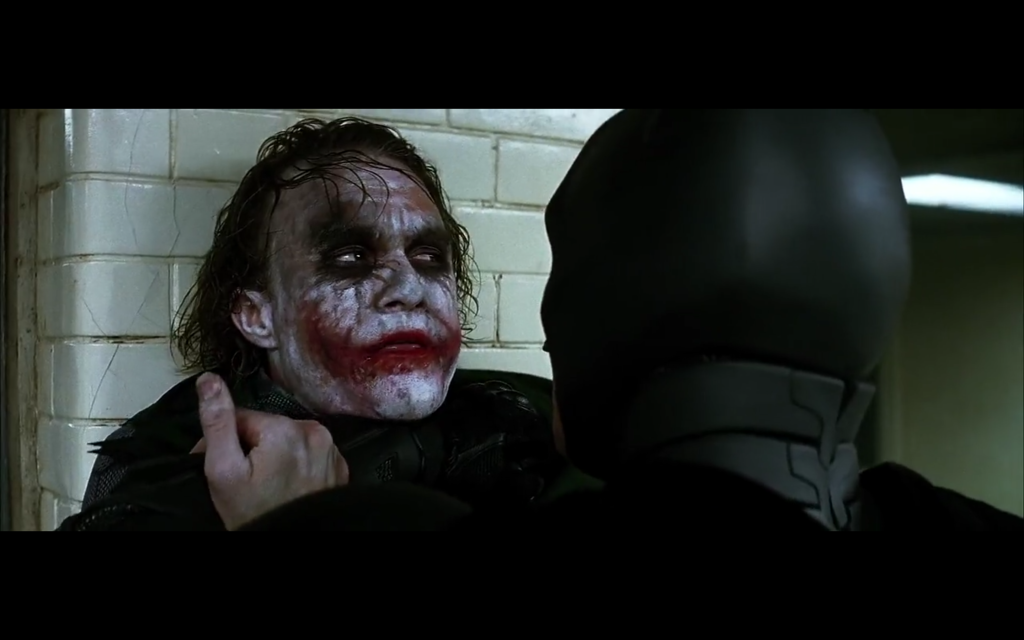Storyboards are a vital tool in maintaining continuity in a shoot.
Continuity will help you to maintain a sense of realism. The storyboard artist must keep an eye on every detail, making sure that every element, every item and action makes sense in relation to the rest of the sequence, particularly the adjoining scenes. The director should be loyal to the details in the storyboards in order to avoid continuity mistakes between different takes (a misplaced prop, wrong detail of the costume, wrong flow of the action etc).Audiences may not be aware of why a sequence isn't convincing but they will know that they haven't been convinced.
Look at the stills from the interrogation scene in ‘The Dark Knight’ for a vital continuity mistake:
When Batman holds Joker up against the wall, Joker’s hands are holding Batman’s forearms upside down – from underneath.
When the frame changes his hands are now on top of Batman’s forearms,
then it cuts back and his hands are under again.
You don't need to be a brilliant draughtsman to avoid continuity errors, you just need to know what to look out for and indicate them on the storyboard. Maybe you can't wait to get filming and doing the fun stuff like acting but put a lot of work into the pre production and you will reap the benefits at the edit stage of the process.
Camera Angles
The same scene can be shot in a variety of ways, each can covey a different feeling for the audience – camera angles are the main things responsible for this.
Different placements of cameras can make the same action look more dramatic or less dramatic, depending on its placement : flat, angled, eye-level, tilted up, tilted down, bird’s eye, worm’s eye etc.
Storyboards are the first time the written word becomes visual.
So, the storyboard artist should use the camera angles wisely, the work done here sets the tone for whole piece.
A lot depends on the feeling the writer and the director want to convey to the audience and shot types need to be considered carefully.
In addition, a sequence can become confusing if too many angle changes are used for no real reason.
(Hobbit – An Unexpected Journey, 2012, Peter Jackson) High angle shot is used to emphasize how small Bilbo Baggins feels (and is) as compared to the grandeur of his surroundings.
(Matrix, 1999, The Wachowski Brothers) Remember how weak and desperate Mr. Anderson felt when he was talking to Morpheus on the telephone just before he was captured by the agents? Don’t you feel that claustrophobia and anxiety with this high angle shot?
(Citizen Kane, 1941, Orson Welles) One of the most important pieces of cinema history, Citizen Kane, is well known for its low angle shot scenes. Welles uses these shots during the movie to make the audience feel the change of confidence and power in Kane. These shots are less frequent in the beginning, suggesting him to be equal to his peers. As the movie continues, nearly in every scene we see a low angle shot of him.
The example above is taken from the election speech scene, an excellent example of the subject.
The scene starts with a distant shot of him, picturing him more or less about the same scale as the others.
As Kane continues with his enthusiastic and furious speech, the camera pans down to the bottom of the podium, making him seem very tall. Now almost same size with the giant portrait behind him, Kane is a powerful man, superior to everyone else in the scene.
(Inglourious Basterds, 2009, Quentin Tarantino)
One of Tarantino’s trademark shot types, showing the characters from below. Notice how dominant, powerful and confident they look from the POV of their victim.
A low angle shot of The Joker puts him in a position of pwer.
Skyfall - Silva's Opening Speech - rats!
There are only five edits here.
The wide shot sets up the sequence, the lift door seems a long way from Bond who is kept in a confusing, place surrounded by complicated machinery. As Silva gets closer he gets more intimidating.
The close up shows Bond to be processing his thoughts but he isn't afraid. The over the shoulder shot puts the audience next to him, looking up at Silva who has the advantage here.











No comments:
Post a Comment